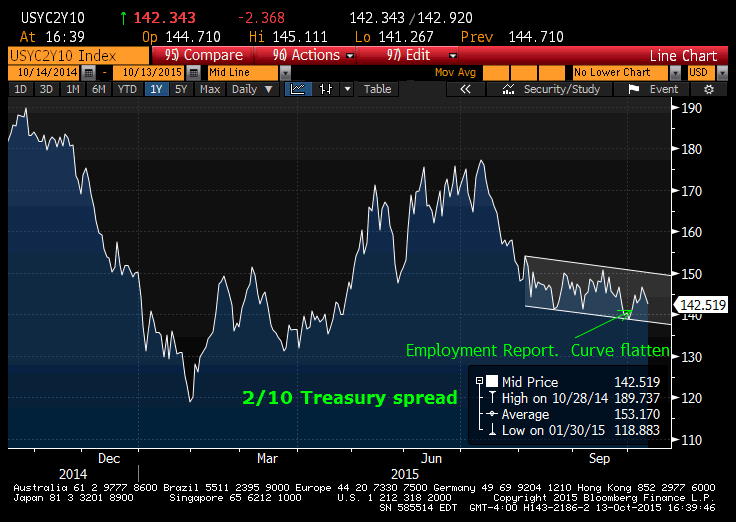Since the disappointing US employment report on October 2, there has been a significant bounce in “risk” assets. For example, on October 1, ESZ5 closed 1916.75, but one week later it was nearly 100 points higher at 2006.50. Emerging market currencies which had been under severe pressure throughout the summer also had significant bounces, as the weak jobs data diminished the threat of Federal Reserve rate hikes. However, those who think that restraint on the part of the Fed will “fix” vulnerable markets are sorely mistaken. These bounces were simply relief rallies that have probably run their course as of yesterday (Tuesday) afternoon.
Ordinarily, the idea of a looser than expected central bank would steepen the yield curve. Indeed, in the wake of the employment report there was (very) modest steepening. For example, the two year to ten year treasury spread went from 138.8 bps on October 1, to 146.7 on October 8. However, on Tuesday it was back down to 142.5.

A steeper yield curve is typically associated with inflation, as monetary stimulus (or lack of tightening) is expected to give the economy a bit of a boost. In the current environment, the yield curve isn’t signaling anything of the sort. The ten year note yield is hovering just above 2%. Fed Governors Lael Brainard and Daniel Tarullo have both suggested that the Fed hold off on the idea of hiking, Brainard on Monday and Tarullo on Tuesday. Brainard noted that the increase in corporate bond yields and widening spreads to treasuries has already been equivalent to monetary tightening. The yield curve agrees.
As I have mentioned previously, the largest one-year Eurodollar calendar spread is only about 55 bps, an indication that the market doesn’t perceive more than about 50 bps of Fed tightening in any given year. Whether looking at treasuries or the Eurodollar curve, it’s difficult to make the case that the Fed is expected to be aggressive in terms of tightening. However, risk assets have only seen modest bounces. Continued caution is warranted in equity portfolios.
Alex Manzara/ RJ O’Brien




